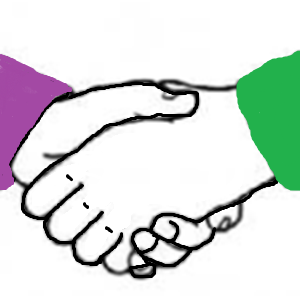Did You Know?
The Left-Handed Handshake

All over the world Scouts greet each other with a left-hand handshake. The handshake is made with the hand nearest the heart and is offered as a token of trust and friendship.
Various sources have attributed the origin of the handshake, as an ancient sign of bravery and respect, to Lord Baden-Powell’s encounter after a battle with the King of the Kingdom of Ashanti, in what is now modern day Ghana. African warriors, who used their left hand to hold their shields, would lower it and shake another person’s left hand to show they trusted each other. Having fought against him and with him, the Ashantis knew of Baden-Powell’s bravery and were proud to offer him the left hand of bravery.
Tying Knots

Another Scouting obsession! People have been tying knots for thousands of years. Today, despite technology, knots are still as necessary as ever and Scouts are (or should be!) masters of knot tying.
All knots have a purpose and it is just as important to understand what that purpose is, and when the knot is used, as having the ability to tie it.
Here is an animated guide containing everything a Scout needs to know about tying knots. They just need to find some rope to get cracking.
Scout Badges

Our badges and awards are part of what makes us Scouts. And Scouts love earning them! You can read more about scout badges here:
Whereas, as they get older and more capable, we would encourage our members to sew on their own badges, the reality is that parents end up doing the majority of the sewing and we have never met one that enjoys it. You can buy badge glue but it doesn’t work very well and leaves a mess when used for badges that are not worn permanently, such as the King’s Coronation Badge.
We recommend that you watch this Youtube video by Penny from Manx (Isle of Man) Scouts before you start sewing on badges, as, in the long run, using this method will save you a lot of time and effort!
The Patron Saint of Scouting

St George’s Day is celebrated on the 23rd of April. Saint George is the Patron Saint of England and also the Patron Saint of all Scouts around the world. His flag is the red horizontal cross on a white background and his emblem is a knight slaying a dragon.
The legend goes that George was a son of a nobleman in the Roman army, and became a cavalry officer. George became a Christian and decided to leave the army and travel to the palace of the Emperor, Diocletian, to plead with him to stop his cruel persecution of Christians. As he rode on his horse through Sylene (in present-day Libya), he found that one of the cities was plagued by an evil dragon that lurked in a swamp. This terrifying creature could only be pacified by feeding it with human bodies, and every day one of the citizens was chosen by drawing lots and was sacrificed.
The King’s own daughter, Cleolinda, was going to be the victim on the day that George arrived. He hurried to help her, even though his only weapon was a spear. With awesome courage he charged on his horse, knowing that he had only one shot at killing the fire-breathing dragon. He succeeded and saved the princess’s life.
After talking to George, the grateful King, the princess, and many of the people decided to become Christians. George continued to the Emperor’s palace, but Diocletian had him put to death on 23rd April AD303 for his Christian faith.
So why did Baden Powell choose St George to be the Patron Saint of Scouting?
Baden Powell choose St George to be the movement’s Patron Saint because he admired the qualities of the legendary Roman soldier; qualities that reflect good Scouting:
- Responsibility
- Truthfulness
- Devotion to duty
- A brave heart
- A noble spirit
- Dedication to helping others
Founder's Day


Founder’s Day is celebrated throughout the scouting world on 22nd February and honours Lord Baden-Powell and his wife, Olave, the first Chief Girl Guide.
It’s a time for Scouts and Guides to reaffirm their oaths together and contemplate how Scouting’s century-old values are still relevant in today’s fast-paced world.
Coincidentally, 22nd February is the birthdate of both Robert and Olave Baden-Powell!
Why is camping so important to Scouting?
Many people have the impression that scouts love camping – and they are right! Camping has always been an important part of Scouting. It is great fun, whatever the weather, and is great for the young person’s (and the leader’s) resilience and determination. It is a great opportunity to put all those scouting skills, such as being able to erect a tent or start a fire or chop up wood, into practice!
The young members also learn lots of other skills, such as how to look after their personal hygiene, self discipline and responsibility.
Why do Scouts love camp fires?
Everyone in scouting loves a good camp fire!
Camp fires can be a quiet moment with a handful of close friends, or they can be a well-planned event to entertain hundreds. They’re a fantastic safe space for the singers, the storytellers, the actors, and the chefs to practice their talents. A campfire doesn’t care what uniform you wear – they bring everyone together, allowing Squirrels, Beavers, Cubs, Scouts, and Explorers to share stories, memories, songs and jokes together.
A fire provides warmth, a place to cook or boil water as well as a focal point for the camp. Knowing how to light a fire as well as extinguish and clear away afterwards will ensure Scouts are prepared for a survival situation and leave no harmful impact on the area they camp in.
Being able to light a fire is not as easy as you might think. It takes years of practice to be able to do it properly in all weather conditions with only the materials available to you. This is where some of those knife, axe and saw skills really come into their own.
Why do Scouts love smores?
Also known as s’mores, smores are a favourite with scout groups, especially around a camp fire. In essence, a smore is melted marshmallow inside two chocolate digestive biscuits, but everyone has their own spin on how to make them the best way.
Allegedly, the first mention of this treat is in a 1927 edition of the Girl Scout manual ‘Tramping and Trailing with the Girl Scouts’. In a nod to the treat’s addictive qualities, it was dubbed “Some More.”
Neckerchiefs (Neckers)

Why do Scouts Wear Neckerchiefs (Neckers)?
The origin of the scout uniform can be linked to the South African Constabulary (peacekeeping group) that Baden-Powell commanded while overseas. According to Scouting for Boys, the book that Robert Baden-Powell published in 1908, the uniforms they wore were “comfortable, serviceable, and [offered] good protection against the weather.” And they wore neckerchiefs! As such, he thought scouts should have a similar uniform.
In addition to the sharp look that the neck scarfs gave his unit, Lord Baden-Powell noticed the practicality offered by neckerchiefs, especially when first aid was required. If a scout was in a pinch and needed to make a splint, a sling, or a bandage for themselves or someone else, their neckerchief could be used!
Picture copied from Scouting for Boys by Robert Baden-Powell, 1908
What Else?
The neckerchief was also commonly used to protect scouts’ necks from sunburns, as well as used as an emergency rope in some cases. However, the neckerchief wasn’t just a practical first-aid tool, it was also used symbolically in several ways! Lord Baden Powell once stated:
“Every Troop has its own scarf colour, and since the honour of your Troop is bound up in the scarf, you must be careful to keep it clean and tidy.”
And that’s why we ask our beavers, cubs and scouts to keep their neckers clean and tidy!
Jamborees

What is a Jamboree?
In Scouting a Jamboree is a large gathering of Scouts, who get together either on a national or international basis for a camp, or similar where they take part in a range of activities which can vary from caving to pottery and nearly always involve some sort of service project.
Where did the term Jamboree originate from?
The name is thought to be derived from the Swahili for hello, “jambo”, as a result of the considerable amount of time he spent in the region. Lady Baden Powell is said to have used the term Jamboree to describe how Scouts from different nations and cultures where able to communicate with each other, despite the language barrier.
World Jamborees
Every 4 years the Scout movement holds a World Jamboree, in one of the countries of the world.
The Gang Show

What is a Gang Show?
A Gang Show is an amateur theatrical variety show where the cast is made up of members of the Scout and Guide Movements, mainly consisting of song, dance and short comedy sketches. The cast spend many hours rehearsing for the show and members of the backstage team spend more time on costume design, stage building and sourcing props required for the show. The shows are normally put on in commercial theatres over a period of several days, which gives the public a chance to come and watch the show.
It was once said that “Every night of every year, somewhere in the world, a Gang Show is playing”.
Sir Harry Secombe, Sir Richard Attenborough, Peter Sellers, Darryl Stewart, Max Bygraves, Spike Milligan, Norrie Paramour, Dick Emery, Tony Hancock and many other stage and film stars were involved in Gang Shows early in their careers and have contributed in building the Gang Show tradition.
World Scouting

How big is Scouting?
Scouting is a global movement with over 57 million Scouts worldwide and 174 National Scout Organisations.
The World Organisation of Scout Movements (WOSM) is an international body that supports Scouts across the world.
Click this button to find out more:




